#so it's possibly they pick songs that mostly just fit with the unit's overall image in their main story
Explore tagged Tumblr posts
Text
You know I think it's more appropriate to consider covers in project sekai representation of like performances or songs the unit would sing mainly cause I've realised there are a lot of difference between unit's musical style and the story itself.
The biggest like difference you can see is in MMJ and WxS's cover choices (and even comm producer choices sometimes).
Often MMJ get the more serious and sad songs even though story wise it doesn't necessarely always matches with MMJ's own story which is more or less pretty positive as of right now.
Compared to WxS, who during probably their lowest point in their story they got covers like Childish War and Wonderful Cat's Life.
Now I don't like comparing unit angst or something like that but MMJ overall has been doing better than WxS in terms of character moral.
So like the difference kinda creates a tonal dissonance for me ? So in the end I think what the covers are meant to be in that case is simply how the unit presents itself.
Idk what the take away to this is, it was just like an interesting thing to point out.
#wxs#wonderlandxshowtime#mmj#more more jump#project sekai#pjsk#to be fair also colorpalet probably expects newcomers to come at any time and doesn't expect everyone to have read the whole story#so it's possibly they pick songs that mostly just fit with the unit's overall image in their main story#which mmj's main story is at least at first “more sad” than wxs#as well since the premise of mmj was idols that gave up#again also music style has a part in it as well as mmj kinda has a gentle style of music#thats why you have songs like kyukarin like kind of that gentle cute music
21 notes
·
View notes
Text
Why Not Wargame World War I or Vietnam?

Historical Wargaming, like many hobbies, has fads. One year, Ancients might be big, or it may be Colonials. The next, World War II. But two periods have not, at least in my own observation, gotten their day in the sun. At least not in US wargaming circles (and I will be speaking almost exclusively to that, as I am less familiar with, though still knowledgeable of, the British wargaming scene).
These periods are the First World War and Vietnam. Both were major conflicts with plenty of research materials available (unlike, say, the Grand Chaco War). Both have libraries of rules and boardgames written for them, but neither, at least not at the cons I’ve attended, are quite the attention-getters that other conflicts do. Why is this? I have some theories as to why.
Just a disclaimer, this is mostly an opinion piece, and your mileage may vary.
American and British Views of the First World War and Vietnam
Let’s face it. Most American wargamers are patriotic folks. We want to play wargames where “our boys” feature prominently. World War II more than fits that bill. World War I does not. By the time the American Expeditionary Force arrived in France in strength in early 1918, the German Army was on its last legs. The Americans arrived in theatre in time to push the Germans off the proverbial cliff when the last German offensive in the west failed. Our active participation in the First World War was barely six months. Our fleets fought no major battles, and by the time we were shuttling troops to Europe, the U-Boat and raider menace was a shadow of what it used to be. In the air, American heroes were made, such as Frank Luke and Eddy Rickenbacker, but they, too, missed the worst of the Allied fortunes of the previous year.
In short, while American forces improved the overall strategic position of the Western Allies, the US Army was poorly prepared for the modern battlefield. Many of the American offensives, in the beginning, used the same types of massed frontal assaults that the British and French had abandoned the previous year due to the horrific casualties involved. The US Army often had to buy equipment from the British and the French to supplement their own needs, as our own industry had not geared up for war by the time the war ended.
In short, our role in the First World War was a minor one, relatively speaking. And that carries through to American wargamers. British wargamers learned a quite different lesson about the First World War from their school classes and their families than we did. We had 4 million men in the military for the First World War, half of that went to France, and half of that saw any combat. Compare that with the Second World War, where you had 15 million Americans in the military. So, for many wargamers of a certain age, they were more likely to have a World War II veteran in the family at some point than a World War I veteran.
In Britain, this was different. Over 5 million men in Great Britain enlisted, which was almost 25% of the male population at the time. Add in the fact that the British lost almost 750,000 men worldwide over four years and the United States lost 110,000 in the space of five or six months, a different image of World War I appears. In the US, it is a conflict we do not game much because nobody pays much attention to it (though, with recent movie releases such as 1917, this seems to be changing). In Britain, World War I is seen as a national tragedy. It is of boys being sent off to the slaughter at places like the Somme and Passandachele. And since Britain is in many ways the “mecca” of hobby wargaming, it is inevitable that a feeling of “No, that’s just not something we want to game out” took hold for an awfully long time.
Moreover, the Western Front was not a war of movement except at the very beginning and end. That is why most boardgames on World War I tend to concentrate either on other theatres (the East is extremely popular), 1914 or 1918. Miniatures games tend to center around the same, or game out the war in the air or at sea.
Vietnam is the opposite in so very many ways. American participation in the conflict was massive from the beginning, and the conflict lasted ten years. Approximately 2.7 million Americans served in Vietnam, and the war showcased some advanced weapons systems on both sides. But it was an unpopular war at home that tore the social fabric of the time asunder. Wargaming in this country truly came of age in the 1970s, and Vietnam was still seen as a “dirty” war, again, one not worth gaming. In British wargaming circles, Vietnam has been big and never really stopped being big. I remember all my British “glossies” (slang for the British Wargaming magazines, named as such for their glossy covers) full of articles on Vietnam.
There was a small uptick in gaming Vietnam in the mid-to-late 1980s in this country, as various movies came out from Hollywood, but the nature of the conflict is not easy to game. Vietnam epitomized the old saying about combat: “Long periods of boredom punctuated by short, sharp moments of sheer terror.” There were long periods of time where patrols would go out and find…nothing. Then a patrol would go out, and all hell would break loose. That is not easy to game. That is the larger truth at the tactical level about counterinsurgency. It’s not how many guerillas you kill, but it’s what you do to use “soft power” to undercut their support. That said, I have seen some good miniatures games on the subject, but most board games on Vietnam seem to be focused on the strategic and operational levels.
Add in the popular beliefs about Vietnam and the men who fought there. None of them were true, but the media popularized them in the day, and popular opinion demonized the soldiers who fought there. Going back to fads, it was not hard to see why American wargamers to this day get a little queasy about gaming Vietnam.
Availability of Games and Miniatures
I am happy to say that times are a-changin’, as the old protest song from the Vietnam-era goes. Perhaps with World War I, there are no veterans in living memory, and there’s better history being done now (especially new history on the tactical innovations developed on the Western front putting an end to the pernicious myth of half-trained boys being slaughtered by uncaring commanders). And with Vietnam in this country, we are starting to see more Vietnam veterans opening up about their experiences and game designers and rules writers listening to them.
So, here is an overview of what is out there both board gaming and miniatures-wise:
Board Games World War I

Ted Racier has written quite a few games on the First World War. It is not a period I game for the most part, but I played the 1918 game back when he published it in Command magazine. I personally think it was one of the three best games Command ever published, and I am glad to see GMT is bringing it back.
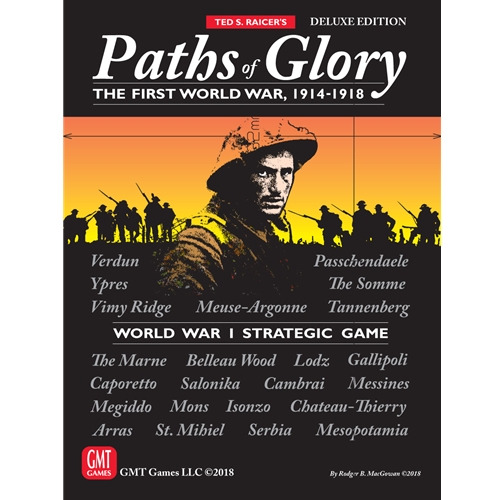
We all know what I think of this game, and I think it was a welcome window into the strategic realities of World War I. It is still one of the best Card Driven Games of all time.

I do not own this game, but the premise of doing a worldwide game of the First World War does intrigue me. It seems to put proper focus on economics and diplomacy, with the war of movement slowing down into an attritional model. All in all, it looks good, but if someone who has played it could let me know how it plays, that would be appreciated.

This game has been out for a while, and I had also heard a lot of buzz about it when it was released. Clash of Arms could have had a solid game in this, and I played it once. The rules needed a lot of work and probably could have used the “living rules” concept that other game companies used.
Board Games Vietnam
A note, this is not all-inclusive as there are a lot of Vietnam board games out there. I had to cherry-pick which ones would be of the widest possible interest.

For a while, this game by Victory Games was the game on the Vietnam War. It was truly a monster game and covered every aspect of the war, from pacification to how dedicated the combatants were. It was well-designed and state of the art for its time. Sadly, it is out of print and not cheap to come by, but it is worth it if you can find a copy.
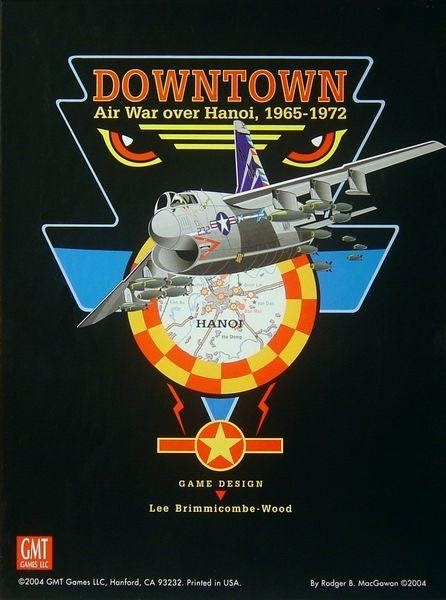
Downtown is probably one of the best games on what goes into planning and running an air campaign out there today. GMT still has the game in print (it is one of two games on Vietnam I own), and I have played it on VASSAL a few times. I really do like it. The designer, Lee Brinscombe-Wood, has gone on to write An Elusive Victory (The Arab-Israeli wars in the air) and The Burning Blue (The Battle of Britain), and Red Storm (A hypothetical Third World War in the skies over Germany) were also written all using the same rules system. The game details well the frustrations faced by the Americans over the skies of North Vietnam. You can purchase a copy here.
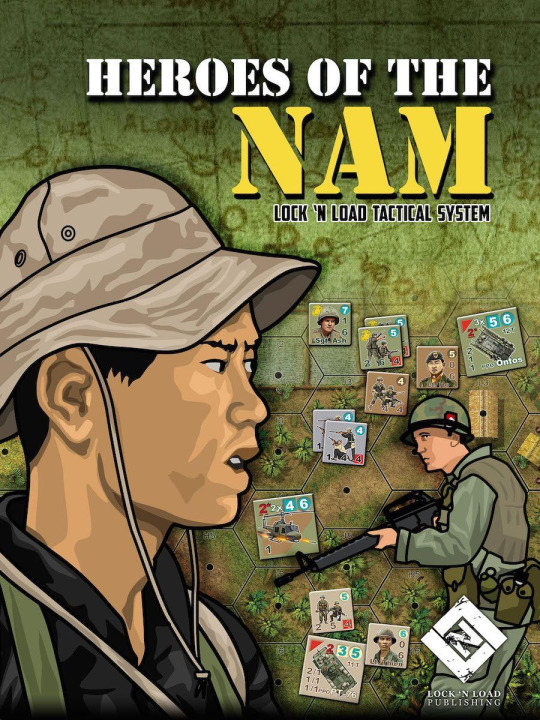
Mark H. Walker did some really neat work with his Lock ‘N Load series, and one of the first games in the series was about Vietnam. Lock N’ Load is a system that is at the same level as Squad Leader but is a bit simpler to play, but no less nuanced nor fun. I own the 1st Edition of Band of Heroes and will one of these days go out and get the new versions of the series. All of them play the same, with an emphasis on putting tactical decisions into the hands of the player, keeping the game moving and fun, with most scenarios taking no more than an hour or two. You get all the troop types: US Army, USMC, ARVN, NVA, VC, and yes, even Australians (for those wanting to game out the movie Danger Close). You can get a copy here.
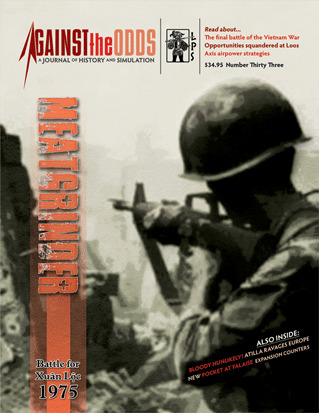
Meatgrinder is a game from the folks at Against the Odds magazine about the last stand of the ARVN at the town of Xuan Loc in 1975. The rules are beautifully written, and the articles that come with the game are incredible reading at times. It is games like this that remind us that there was still a war going on after the US pulled out in 1973, and the fall of South Vietnam had consequences. And it is just a great story of a hell of a stand. You can purchase a copy of the issue and the game here.

This was the game that was on everyone’s minds when it came out in 2014. The COIN series is an innovative set of games designed around a common rule set that games out insurgencies like Cuba in the 1950s, Columbia in the 1990s, and Afghanistan today, as well as Vietnam. I have yet to play any of the COIN games, but I want to. They are all highly recommended and address the problem of counterinsurgency quite well in a strategic context. You can purchase a copy here.
Miniatures Rules for World War I and Vietnam
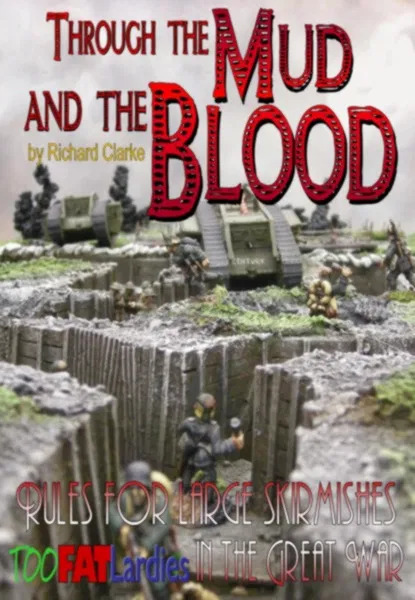
Richard Clarke has a reputation with Too Fat Lardies for putting out good rules with card-driven mechanics. It is not everyone’s cup of tea, but it can produce a good game. I haven’t played Through the Mud and the Blood myself, but it has very good information on the various armies of the Western Front and the tactics they used, with the rules author making a fine argument that the tactical innovation opened up the stalemate of the Western Front in 1918 (it did). Too Fat Lardies’ products can be found all over the internet or in PDF or physical format on their website.

Peter Pig’s rules are meant for larger-scale fights, where each stand of troops is about a company in size, and the 6’x4’ board is sub-divided into squares and plays something like a board game. I will not say it is my cup of tea but may swear by it. You can buy digital copies via Peter Pig.
There are several rules for World War I also on Wargames Vault, and some, like Westfront, sound intriguing, but take a look for yourself.

Even though Force on Force is still sadly out of print, their Vietnam sourcebook and rules were probably one of the best rules sets out there for gaming the Vietnam war. Happily, PDF copies are still available for sale from the publisher for $20.00. You will need the base rules to play as well, but those are also available on PDF from the publisher.
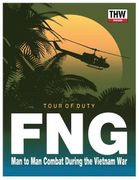
Two Hour Wargames (THW) has been blurring the line between RPGs and Wargames for a while now and promising (and delivering) games in under two hours. Their Vietnam game is no different, as the game is centered around the idea of your “character” controlling a squad, and like most THW products, the game has very simple rules. There is also a campaign generator for scenarios you can play out on the tabletop. It is a great fun, pulpy take on Vietnam and is well worth the $20.00 price tag. The rules are for sale in PDF and can be found here.
Next week, we’ll discuss miniatures themselves, as that’s going to take an entire article in its own right!
--
At SJR Research, we specialize in creating compelling narratives and provide research to give your game the kind of details that engage your players and create a resonant world they want to spend time in. If you are interested in learning more about our gaming research services, you can browse SJR Research’s service on our site at SJR Research.
--
(This article is credited to Jason Weiser. Jason is a long-time wargamer with published works in the Journal of the Society of Twentieth Century Wargamers; Miniature Wargames Magazine; and Wargames, Strategy, and Soldier.)
4 notes
·
View notes